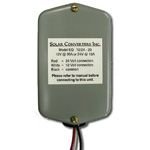Think of it like this. If you take a positive lead and a negative lead(pair of jumper cables) off of the rear battery(next to the firewall) and stand away from the truck, you will be at least 12 volts(negative lead) higher than the fender you are leaning on. Now you tap the positive cable(positive lead) against the fender and you get a 24 volt ZAP!!So flat out don't use rear For Any!!! 12v because of possible unforeseen breakdown in alternator, don't be dependent on something that can fail and cause further and more severe damage, Is that it Doghead?, Thanks and I just want to understand more as I travel down this road of CUCV
The rear battery( and its alternator) is in series to the front battery.
You can tap off the rear battery but most everything that uses voltage has a chassis ground.
So having an electrical do-dad getting powered off of the rear battery and having it touch the truck at any point is like bouncing the negative or positive jumper cables off of the fender in the top example.
You have to have whatever electrical do-dad you use (that gets voltage from the rear battery) floating in space (air).
Every thing powered off of the rear battery is at least 12 volts potential to as much as 24volts relative to the truck surfaces. It will make a ZAP if it contacts the truck surfaces!






